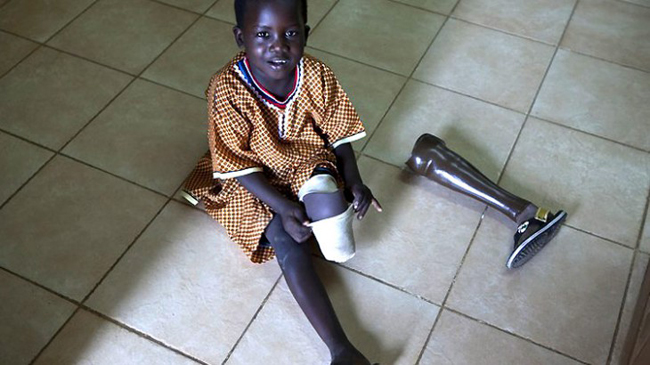|

|
 |
|
Last Updated: Feb 13, 2017 - 1:45:37 AM |

In South Sudan
|
Anti-personnel
landmines, cluster munitions and other explosive remnants of war (ERW)
are a malign presence across the world. They continue to do great harm
long after conflicts have ended and peace agreements signed. In the past
decade, over 50,000 people have lost limbs or lives to these weapons.
The International Day for Mine Awareness and Assistance in Mine Action is observed throughout the world on
4 April
every year. It serves as a reminder to the international community to
help establish and develop national mine-action capacities in countries
where mines and ERW are a serious threat to the safety – even the lives –
of civilians or an impediment to social and economic development.
In late 2013 and early 2014, the International Committee of the Red
Cross (ICRC) sent five photographers to five countries – Bosnia and
Herzegovina, Iraq, Laos, Mozambique and Nicaragua – to document the
human toll exacted by mines and other ERW. The images capture both the
dedicated work of those involved in clearance operations, and the
anguish and resilience of survivors.
Mozambique
Since 1993, the United Nations and various non-governmental
organizations, including the HALO Trust, Handicap International,
Anti-Personnel Landmines Detection Product Development and Norwegian
People’s Aid, have been steadily demining Mozambique in collaboration
with the National Institute of Demining. Mozambique hopes to complete
demining operations in 2015 – a significant achievement in this once
heavily mine-affected country. However, the needs of mine victims will
remain. Government estimates put the number of casualties at 10,900.
Bosnia and Herzegovina
Landmines and other ERW continue to be a source of great concern in
Bosnia and Herzegovina. Their presence dates primarily from the
1993-1995 war in the former Yugoslavia. They contaminate some 1,263 square kilometres and have caused 8,075 recorded casualties, of whom more than 5,800 survived.
Iraq
Iraq is heavily contaminated with landmines and other ERW, the result of decades of armed conflict
and sectarian violence. The number of survivors of mine/ERW-related
incidents is estimated to be anywhere between 48,000 and 68,000. Its
commitments under the Anti-Personnel Mine Ban Convention require Iraq to
try to rid its territory of all anti-personnel mines by
1 February 2018.
Laos
Between 1963 and 1972, during the Vietnam War,
at least 270 million cluster submunitions were dropped on Laos. Tens of
millions of them failed to detonate. Over 20,000 Laotians have been
maimed or killed by cluster submunitions since the official end of the
war in 1973. About 80% of the country’s 6.8 million citizens are
subsistence farmers, which means that thousands of them are daily
farming land dangerously contaminated with cluster submunitions and
other unexploded ordnance.
Nicaragua
Nicaragua ratified the Anti-Personnel Mine Ban Convention in 1999. The
civil war of the 1980s left 16 of its 17 provinces mine-affected,
particularly rural and impoverished areas. In 2010, Nicaragua was
declared mine-free, having cleared over 179,000 anti-personnel mines
from its territory and half a million pieces of unexploded ordnance.
All of Central America is now mine-free – a major advance in the fight
to rid the world of anti-personnel mines. There should be no new
landmine victims in Nicaragua, but at least 1,200 survivors of landmines
and ERW will continue to require assistance.
The ICRC is active in mine-clearance efforts in many other countries,
such as Afghanistan, Cambodia, Chad, Colombia, the Democratic Republic
of the Congo, El Salvador, Ethiopia, Guinea-Bissau, India, Iraq,
Myanmar, Niger, Pakistan, Peru, South Sudan, Sudan, Tajikistan, Ukraine
and Yemen. It collects and analyses data, and surveys and clears
landmines and other ERW; it also undertakes activities in connection
with risk reduction and risk education. In addition, victims of
landmines and ERW benefit from physical rehabilitation, surgical care
and economic security programmes provided by the ICRC.
Images and other materials on this issue available at:
https://www.icrc.org/en/
legacy-mines
For information on the ICRC’s work to help people with physical disabilities, go to:
http://sfd.icrc.org

© Copyright 2015 by thebahamasweekly.com
Top of Page
|
|
 |

|
